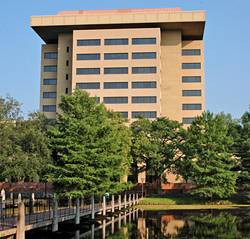Fish ponds lowered to prevent algae growth
Posted by Jayme Blaschke
University News Service
December 13, 2007
 |
Around 6 to 12 inches of water will be drained from the fish ponds and redistributed to neighboring ponds. The drop in temperature will reduce the algae population in the more shallow ponds and slow down the physiological process of algae to reduce growth.
There are about 30,000 species of algae found in all aquatic environments including marine, freshwater and brackish water. In high densities, algal blooms may discolor water, grow past sustainable levels and poison other life forms.
“There’s not a problem with the fish living there as far as I know,” said Brad Smith, director of grounds operations. “We’re doing it for aesthetic purposes so those visiting and going to the school can enjoy the scenery and this is a low tech way of controlling it.”
Methods used to control algae at the fish pond surrounding the theatre building on campus include using colored dye to block light from entering the water to prevent photosynthesis and introducing more oxygen into the water through fountains and aeration equipment.
“Our contractor suggested lowering the levels at these other ponds because that equipment isn’t there,” said Smith.
When temperatures rise this spring, the waters will be refilled to original levels, depending on the fluctuations and duration of the winter and spring seasons.
Improvements considered for 2008 include adding fountains and aeration equipment for the ponds that don’t have them.
“Aeration also prevents stagnant water from occurring,” said Smith. “This keeps things looking better.”